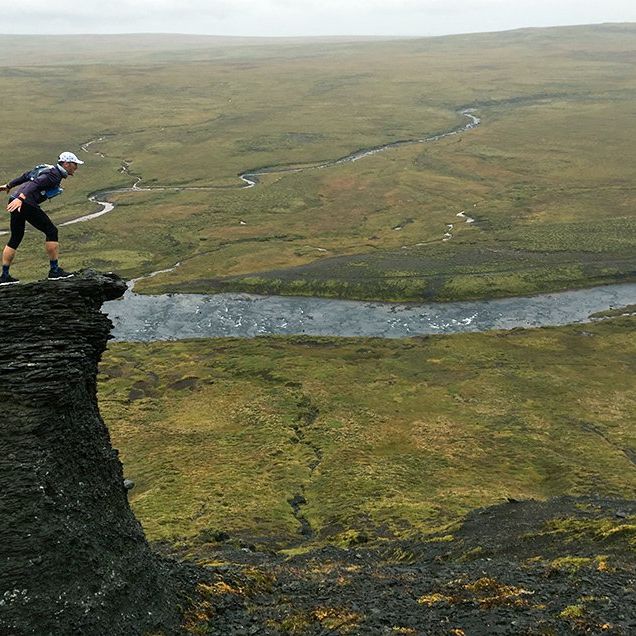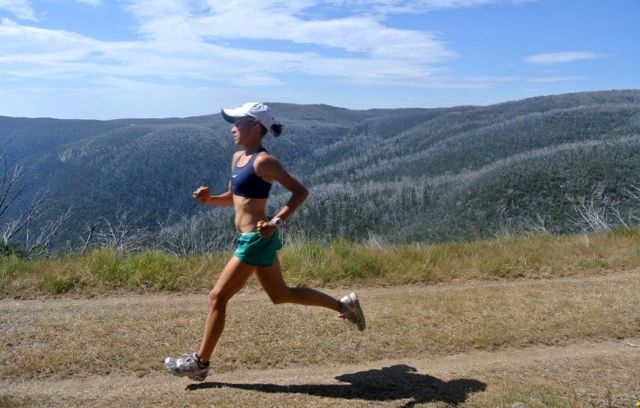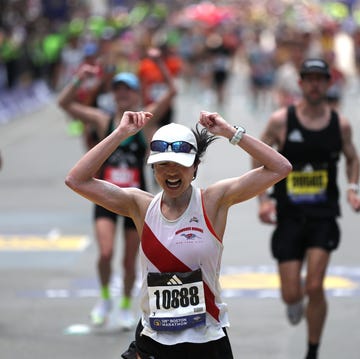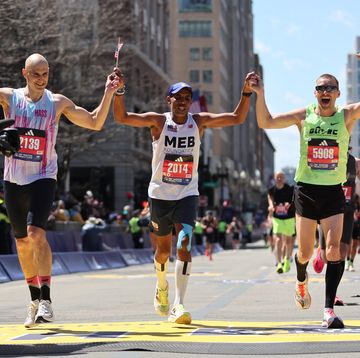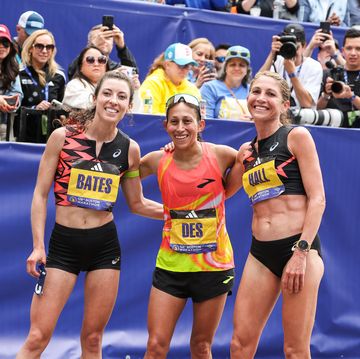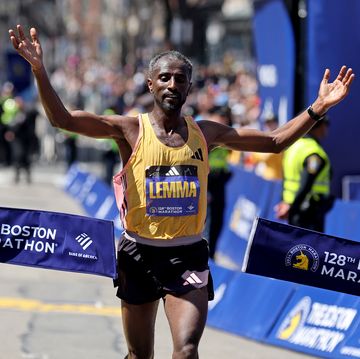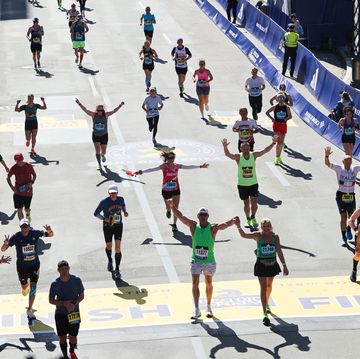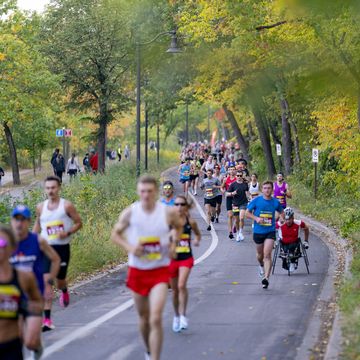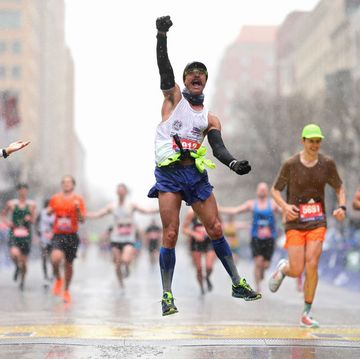Running while traveling—whether you travel for work or fun—can be one of the most invigorating ways to immerse yourself in a new place. Think: a sunrise run along the river in Shanghai, a 10,500-foot-high dash through the mountains above Addis Ababa in Ethiopia, or a sprint at dusk among the streets of Istanbul.
Related: These Are Some of the Most Beautiful Runs Ever
“Running connects you to wherever you are. There’s something about the effort level paired with awareness and observation that allow you to connect [to a locale] on a different level,” says Olympic marathoner Sarah Attar.
Not only does exploring a city on foot (while your body pumps endorphins) help you get to know the city better and more viscerally than you would hopping a ride, but an early morning run can open your eyes to things you might want to revisit later.
“There is no better way to absorb a place,” says Becky Wade, elite marathoner and author of Run The World, who explored running culture in 22 countries for a year, “So many times I’ve passed an intriguing neighborhood or incredible waterfall that I ended up returning to—but never would have discovered if I wasn’t running.”
“You see more, you feel more upbeat, you experience more of what a place has to offer,” says Brogan Graham, a cofounder of The November Project and constant traveler.
Brogan’s wife, Goldie, a yoga teacher and marathon runner, says of her and Brogan’s world-traveling, fitness-fueled marriage: “Our feet have taken us on incredible adventures through unknown streets, trails, tracks, and mountain heads. Running while we travel allows us to both see uncharted territory, and get in a solid sweat.”
Why is running while traveling specifically beneficial? Travel can be stressful and exhausting, and running has been studied repeatedly as an activity that improves a person’s mental state. According to writer John Donnelly, running can even be an antidote to jet lag.
If you think about it, it makes perfect sense—your body needs to reset and get a boost of energy after you’ve hustled through lines at airport security, been cooped up in a too-small plane seat, changed time zones, and found your way through a foreign city.
Jaime Boris, a marathon runner who plans travel and adventure-based experiences for Tragedy Assistance Program For Survivors (TAPS), says, “Running helps me maintain my sanity while traveling—that is my time to recharge and reset. If I’m not at my best, my coworkers will ask, ‘When’s the last time you went for a run?’”
Some cities even offer running sightseeing tours that you can sign up for and check out the city on foot with a group. It make sense to join up with a group—there are a myriad of health and safety issues to think about when running in an unfamiliar location. But there are ways to do it on your own, or with your traveling companions too.
We talked with five athletes who frequently grab their sneakers out of a suitcase for their best tips for running around the globe:
Do Your Homework
“I’m not usually a crazy planner, but when it comes to planning runs abroad, you will find me with maps and web browser tabs open doing research. With a little preparation the runs can be more enjoyable and seamless, and I can spend more of the run taking it all in rather than doing that half-running motion where I’m just constantly figuring out where to go,” says Attar, “But remember, while planning is a crucial part, don’t lose sight of the pure joy and simplicity of getting acquainted with a place.”
Look up Races to Steal Their Routes
Of course you’re not actually stealing anything, but following a race course can give you some peak views: “It’s handy to look up races in the area, because those are usually on some beautiful trails or scenic spots in a city, and they have the course maps on the race website you can use to help guide you,” says Boris.
If You Don’t Want to Use a Map, Head out and Retrace Your Steps Using Keys
Sometimes a phone route can be difficult to stick to—but there are other options. “I think you see more when you’re not checking every turn on your phone or a printed map,” says Brogan, “I like to go for a timed run and do an out and back. Head out for 35 minutes at an easy pace, head up, looking around. Try and keep your turns as few as possible and always give yourself keys to remember which turns you take: a statue, an odd tree, a street sign that could be named after your 3rd grade teacher. Make a game out of it.
“Once you hit your mark, turn on a dime and head back. You’ll need to push it and pay close attention to the keys you built on the way out, so that you don’t get lost on the way back. These keys are helpful, but larger ‘North Star’ keys are good too. I lived in Boston for a zillion years, but I used to keep an eye on the Prudential Center in the beginning.”
Be Flexible and Ready to Change Your Route
Trust your instincts, and stick to well-traveled areas. “Don’t listen to music when you’re in a new place, and be on alert,” says Goldie. “Getting lost can be fun and makes the miles go by quickly,” she adds, “but if you’re in questionable surroundings to begin with, then before you even go out I think it’s very important to ask someone where not to run. If you think you’re in danger, or you’re not sure about somewhere, it’s always better to play it safe.”
Boris agrees, and adds, “If something feels wrong, it probably is.”
Connect With the Local Running Community
“Call or stop by the local running store –they might even point you to a running club or group run that you can join,” says Boris. “I’ll almost always do a quick search to see if there are any club runs or November Project groups.”
Plus, runners love helping other runners out—especially if you’re traveling from afar and interested in their local running community. “The global running community is amazingly receptive and warm,” says Wade, “and no one knows the terrain, climate, or social norms (like waiting at every red light in Japan, or building in a post-run flat white stop in Australia) like the runners who train there daily.”
Your Hotel or Airbnb Can Be a Gold Mine of Information
If you’re trying to find somewhere to run, it’s likely that a previous traveler has had the same question. “If you’re in a hotel, talk to the concierge, they can usually point you in the right direction,” says Attar. “I also love using Strava to learn the area. They have heat maps that show popular running spots, and I love to look up the area that I’ll be in and see what routes people have run around there, it’s helped me find some great spot.”
“Some hotels even have pre-printed cue sheets for runs of various distances,” says Jaime Boris, “Ask the hotel front desk staff or your Airbnb host for their recommendations on where to run (and more importantly, where not to run).”
Related: The Most Popular Running Routes in the 20 Biggest U.S. Metro Areas
Pack to Give Yourself Some Slack
If you know you’re planning to run, then pack all the running gear you might use ahead of time. “I always pack my most reflective running gear, a headlamp, and light, just in case I end up running in the dark. I never leave without my cell phone” says Boris. Not only can it help track your runs and also keep track of where you are on a map, but you can call an Uber or Lyft if you get really lost or go too far and can’t run back.
Boris notes that safety is also important. “I always make sure someone knows where I’m headed and how long I expect to be, whether it is a traveling companion, a friend back home, or the front desk at the hotel,” she says.
In addition, Becky Wade adds another trick, “Stuff a few bucks into your pocket or sports bra, just in case. That gives you some slack in case your run goes longer than intended and you need to catch a bus, make a call, or buy a snack to make it home.”
Run With a Friend When Possible
Whether you’re traveling with coworkers or staying with friends and family, see who might be up for some morning miles—you might be surprised by the answer. “The buddy system is great because you have strength in numbers,” says Goldie.
When she’s not traveling for work, Boris plans trips based around running with friends. “I have traveled with friends who are more than willing to put in a few miles with me,” she says, “In fact, I’m headed to Rome with some friends this spring for the Rome Marathon.”
Enjoy Your Early Peek at the Sights Before the Crowds—and Make a Note of Where You Want to Return to Later in the Day
“I love that it gives me my own space to explore an area,” says Attar. “Since I usually go in the morning, the streets are still calm and empty, a nice contrast to sightseeing amongst crowds. It’s also helps me navigate the area later in the day. I can typically direct my family out of wherever where staying because I learned the streets from the run.”
Boris adds, “As a bonus to my run, I usually stumble upon interesting sights that I never would have found on just a typical tourist itinerary. If I’m traveling for work, I often scope out locations we are using in our events. If I’m traveling for leisure, I’m often able to check out some of the popular tourist sites before the crowds arrive. I’ll almost always make notes on things that look interesting and plot out a route to return.”
Get out During Daylight—but Be Cautious at Dawn
You also should usually avoid running at night in unfamiliar locations for safety issues, and mid-day runs can be nearly impossible to plan and execute while traveling. Brogan says, “Like being at home, it is hard to plan the day with a run somewhere in the middle. My suggestion: get out the door early for morning runs when you travel, or it may not happen at all that day.”
However, make sure you are aware of your surroundings, and are running in a safe area if you head out with the sunrise. “The early mornings are tantalizing, but in unfamiliar places, it can be safer to go out when you have full visibility and plenty people within earshot,” says Wade.
Get out of Your Comfort Zone
“I’ve been able to run along the Red Sea, through a forest in Belize, along the beaches of Rio de Janeiro, in the Cayman Islands, and Dubai, on beautiful coastal trails in the Pacific North West, and through the streets of Rome,” says Attar of her worldwide travels, “As a photographer, I love getting to see smaller details of the place, side streets, different trails, that I would’ve totally missed otherwise. Some of my favorite photos come from these runs.”
But you don’t have to leave the country for incredible views. Brogan adds, “My travels each year to Utah are hard to match—high elevation, the leaves changing color, and steep climbs. Because of the partnership November Project has with The North Face, we get to race Endurance Challenge Events in Park City. I love Utah trails more than most anywhere else.”
In the end, it’s all about those little, beautiful moments, as Boris remembers: “I was out for a long run while on vacation in Ireland a few years ago, and the weather was stereotypically Irish—cool, cloudy, misting rain. Then, the sun started to peek from behind the clouds, and a brilliant rainbow appeared in front of me–it was the most vivid rainbow I’ve ever seen. No matter which way the road turned, I always seemed to be running toward it.”
Gina Tomaine is a Philadelphia-based writer and editor. Her work has appeared in Yoga Journal, Philadelphia magazine, The Philadelphia Inquirer, The Boston Globe, Women's Health, Good Housekeeping, and Runner's World, among others. She's a RYT-200 yogi, neophyte tarot enthusiast, and unapologetic Scorpio. She enjoys the occasional piña colada. Follow her on Twitter/Insta @gtomaine.
